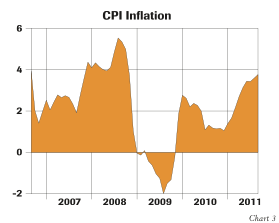2011 Q3 | The Summer of Discontent
 Put simply, it was a terrible summer for both the U.S. and European markets. The economic recovery that began in 2009 stalled, and the anticipated improvement in employment failed to materialize. Continued structural weakness in housing further retarded the overall recovery. Many other industries reported mixed results with one strong month followed by weakness in the next, resulting in a trendless quarter. Estimates for gross domestic product growth in the third quarter were halved from 3.6% at the start of the quarter to 1.8% at quarter-end.
Put simply, it was a terrible summer for both the U.S. and European markets. The economic recovery that began in 2009 stalled, and the anticipated improvement in employment failed to materialize. Continued structural weakness in housing further retarded the overall recovery. Many other industries reported mixed results with one strong month followed by weakness in the next, resulting in a trendless quarter. Estimates for gross domestic product growth in the third quarter were halved from 3.6% at the start of the quarter to 1.8% at quarter-end.
In addition, a political fight over extending the debt ceiling frightened American consumers, slowing purchasing and threatening the economy with a double-dip recession. Though the debt extension was resolved at the 11th hour, it was not without cost. Standard and Poor’s, an established independent bond rating agency, downgraded the creditworthiness of the U.S. government debt from AAA to AA+. While not of major financial significance to the U.S., it was embarrassing. However, these events did have broad-based negative effects, not only on the U.S. equity markets, which declined 13.9% in the quarter, but also on foreign bonds and equities.
The international investment community took note of the U.S. bond downgrade and re-examined the credit of the various countries participating in the Euro. In the aftermath of America’s liquidity crisis of 2008, the Euro gained recognition as a possible alternative to the U.S. Dollar as a settlement currency in international transactions. Missing in this analysis was the fact that each sovereign member country of the Euro had to stand on its own, not supported by a central authority similar to the U.S. Federal Reserve. Also overlooked was the fact that the Euro as a currency was only as strong as its weakest link, which turned out to be Greece. When the financially strong countries participating in the Euro failed to mount an effort to rescue the faltering Greek economy, the markets reviewed each European participant and realized several countries were dangerously overexposed to credit risk on their sovereign debt.
 As this is written, Europe is struggling to find sources of capital to restore confidence in their financial markets. Almost certainly, any European bailout will require enforcement of austerity measures in many countries in the European Union. From the U.S.’ standpoint, any concern that the dollar would be replaced by the Euro as an international settlement currency has lessened dramatically, resulting in a sharp strengthening of the Dollar relative to the Euro. The Dollar is still perceived by the world’s financial markets as a safe haven, and the U.S. bond markets have benefitted as flight capital from abroad has poured into the U.S. financial system. It is ironic that the world’s currency is fleeing to U.S. bonds for safety, after S&P felt justified in downgrading our debt. This has resulted in rising bond prices (see chart 1) accompanied by falling interest rates. Lower rates, although painful to income recipients, are preferable to foreign bond defaults and the potential currency losses associated with those defaults.
As this is written, Europe is struggling to find sources of capital to restore confidence in their financial markets. Almost certainly, any European bailout will require enforcement of austerity measures in many countries in the European Union. From the U.S.’ standpoint, any concern that the dollar would be replaced by the Euro as an international settlement currency has lessened dramatically, resulting in a sharp strengthening of the Dollar relative to the Euro. The Dollar is still perceived by the world’s financial markets as a safe haven, and the U.S. bond markets have benefitted as flight capital from abroad has poured into the U.S. financial system. It is ironic that the world’s currency is fleeing to U.S. bonds for safety, after S&P felt justified in downgrading our debt. This has resulted in rising bond prices (see chart 1) accompanied by falling interest rates. Lower rates, although painful to income recipients, are preferable to foreign bond defaults and the potential currency losses associated with those defaults.
During periods of significant economic uncertainty such as we are presently confronting, the bears and doomsayers cry loudly and are often able to trigger the worst emotional fears in otherwise rational investors. At market turning points, the naysayers scream the loudest, but as conditions inevitably and often slowly improve, the pessimists quietly leave the playing field. Yet, through our many personal experiences of market and economic cycles, we believe we live in an increasingly integrated global economy in which our spirit and hard work have led us to an ever-higher standard of living. In a world where the Western, Asian, and South American economies are largely at peace and anxious for prosperity to return, it is hard to believe that brighter days are not just over the horizon.
Many of our clients have asked, “What are we to do in the face of all of this uncertainty?” Virtually all of our clients have pre-established ranges for asset allocation between money market instruments, bonds, and stocks. As a result of market changes, many of our clients’ portfolios have or are about to penetrate the boundaries of their pre-determined asset allocation ranges. These movements suggest a call for increasing equity and lowering bond exposure in selected accounts.
One of our firm’s central principals is stated in our credo: “Be fearful when others are greedy and greedy when others are fearful.” Attributed to Warren Buffet, this principal has served our firm well in the past. My original partner in this firm, Randy McMenamin, and I have managed money for over 30 years. During that time, we have executed five strategic asset allocation adjustments. In three cases, we reduced bonds in favor of stocks, and twice we reduced stocks in favor of bonds. With the benefit of hindsight, each of these adjustments proved to be successful.
 Now, as your investment advisor, we are again called to be “greedy,” that is, courageous, and respond to market uncertainties which we believe have created a favorable buying opportunity for equities. This rebalancing will be achieved by a reduction in bond and cash holdings.
Now, as your investment advisor, we are again called to be “greedy,” that is, courageous, and respond to market uncertainties which we believe have created a favorable buying opportunity for equities. This rebalancing will be achieved by a reduction in bond and cash holdings.
To date, our bond holdings have proven to be a lifeline to our clients, and have cushioned falling equity values. Just as equities became the darlings of investors in 2000 and again in 2007 just before painful corrections, we believe the current rich bond valuations may be vulnerable to a correction. Accordingly, we are reducing exposure in this asset class.
We are taking this action for several reasons. First, inflation is the enemy of interest rates, and the accompanying chart shows a steady increase in the moving 12-month inflation rate. Anecdotally, our clients are complaining of significant price increases for everyday expenditures, including food and other necessities. In the past, when client complaints have reached these levels, interest rates have risen, the economy has slowed, and in some cases, has tilted into recession. We see no reason why this current discontent among clients who are more dependent on fixed income for living expenses will not correctly forecast higher interest rates and lower bond prices in the near future.
Second, current U.S. Treasury rates across the entire interest-rate curve have not been lower since the government began issuing significant quantities of bonds in the 1930s. If, in fact, we do experience some type of economic growth in 2012, it should be accompanied by an increase in private sector credit demand, resulting in upward pressure on interest rates. Initially, higher interest rates should be a welcome indication that our economic growth is turning up and would be positive for equity valuations, but negative for bond prices.
 The current extremely low interest rates are having an increasingly negative impact on our domestic savings class and financial institutions that have invested in bonds and other fixed-income instruments. Individual investors are experiencing the maturity of certificates of deposit, government obligations, and municipal bonds, and are finding themselves unable to replace the income. The safe income yields that have protected many retirees have now forced the retired to make difficult decisions in order to maintain their income levels. The current low equity valuations are providing yields of 3-4% on investment-grade common stocks such as Intel, Johnson and Johnson, and Proctor and Gamble. As shown above, common stock yields now exceed bond yields for the first time since 1958, leading us to favor stocks over bonds for income.
The current extremely low interest rates are having an increasingly negative impact on our domestic savings class and financial institutions that have invested in bonds and other fixed-income instruments. Individual investors are experiencing the maturity of certificates of deposit, government obligations, and municipal bonds, and are finding themselves unable to replace the income. The safe income yields that have protected many retirees have now forced the retired to make difficult decisions in order to maintain their income levels. The current low equity valuations are providing yields of 3-4% on investment-grade common stocks such as Intel, Johnson and Johnson, and Proctor and Gamble. As shown above, common stock yields now exceed bond yields for the first time since 1958, leading us to favor stocks over bonds for income.
We have included thumbnail profiles of several companies we find attractive. These sketches are shown in the accompanying sidebar that is usually reserved for discussion of a single stock. For additional information on our asset allocation thinking, please contact either me or one of our portfolio managers.



